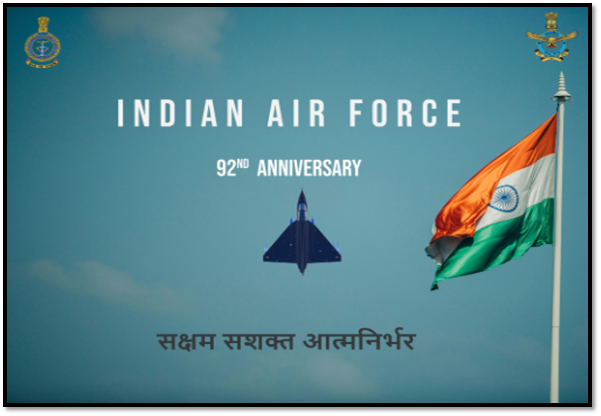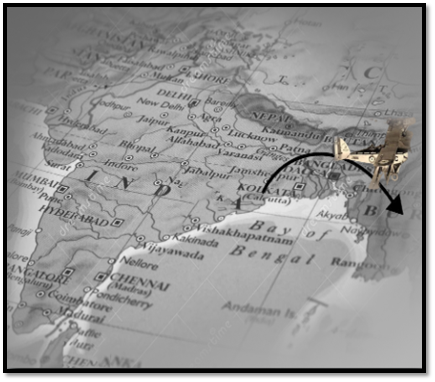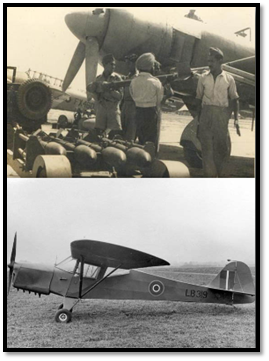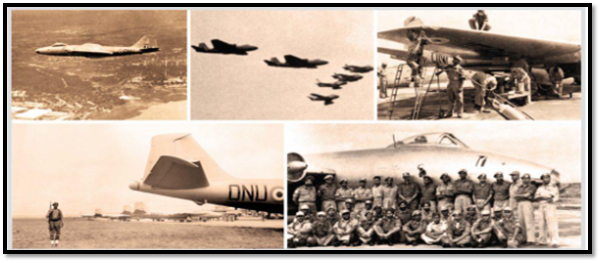Others
The Story of the Indian Air Force: A Journey Through Time
Posted On:
07 OCT 2024 7:18PM
On a crisp October day in 1932, the skies of India welcomed a new guardian—the Indian Air Force (IAF). Established on October 8, this momentous occasion marked the beginning of a vision for air power that would shape the nation’s defense for decades to come. Just months later, on April 1, 1933, the IAF's first operational flight took to the skies, manned by a small but determined group of six RAF-trained officers and 19 Havai Sepoys in four Westland Wapiti IIA biplanes, which formed the nucleus of the "A" Flight at Drigh Road[1], laying the foundation for the planned No. 1 (Army Co-operation) Squadron. This marked the dawn of what would evolve into one of the most formidable air forces in the world.

The Early Years: 1933 to 1941
After the Indian Air Force's first operational flight took off, by 1936, just four-and-a-half years after its formation, "A" Flight saw its first action from Miranshah in North Waziristan, supporting Indian Army operations against insurgent Bhittani tribesmen. In April 1936, "B" Flight was established, also utilizing the vintage Wapiti. It wasn't until June 1938 that "C" Flight was raised, bringing No. 1 Squadron to its full strength. This squadron remained the sole IAF formation when World War II began, although personnel strength had increased to 16 officers and 662 men.
As the global conflict loomed, the defense of India underwent a reassessment in 1939 by the Chatfield Committee. The committee proposed re-equipping the Royal Air Force (RAF) squadrons based in India but offered few recommendations for accelerating the growth of the IAF. However, a scheme to establish five Coastal Defence Flights (CDFs) on a voluntary basis was authorized to assist in the defense of key ports. Built around a nucleus of regular IAF and RAF personnel, these flights operated from major cities, including No. 1 at Madras, No. 2 at Bombay, No. 3 at Calcutta, No. 4 at Karachi and No. 5 at Cochin. No. 6 was later formed at Visakhapatnam.
By March 1941, as demands on the IAF evolved, Nos. 1 and 3 CDFs transitioned from their Wapitis, to Armstrong Whitworth Atalanta transports for patrolling the Sunderbans delta area and received D.H. 89 Dragon Rapides for convoy and coastal patrol duties and single D.H. 86 which it used to patrol the west of Cape Camorin and the Malabar Coast.
This period set the stage for the IAF’s growth and adaptability during challenging times, laying a solid foundation for its future advancements in aerial defense.
Building Capacity: Training and Expansion During Wartime (1941-1946)
As World War II escalated, the Indian Air Force recognized the critical need for a comprehensive training structure to enhance its operational effectiveness. In August 1941, the British Royal Air Force (RAF) assigned flying instructors to various flying clubs across British India, setting the stage for a significant upskilling of IAF Volunteer Reserve(IAF VR) cadets. By the end of that year, 364 cadets received elementary flying training on Tiger Moth aircraft at seven clubs in British India and two in princely states, marking a pivotal moment in the IAF's evolution.
Modernization efforts became apparent as No. 1 Squadron began its transition to the Westland Lysander, bolstered by a full complement of 12 Lysanders gifted by the Bombay War Gifts Fund. This shift represented not just an upgrade in aircraft but a strategic enhancement, allowing the squadron to undertake more complex operations. Concurrently, No. 2 Squadron shifted from the Wapiti to the Audax in September 1941, followed by the formation of No. 3 Squadron, which also adopted the Audax model. These transitions signified a commitment to improving operational readiness, enabling the IAF to respond more effectively to emerging threats.
IAF VR was inducted into the regular IAF.

The urgency of wartime operations drove the IAF's continued expansion. By the end of 1942, No. 2 Squadron also adopted the Hurricane, enhancing its operational capacity.
By late 1942, despite the challenges of limited resources and aging equipment, the IAF managed to operate five squadrons effectively. The disbanding of coastal defense flights allowed for a reorganization of personnel, culminating in the formation of No. 7 Squadron, which transitioned to the U.S.-built Vengeance I dive bomber in mid-February 1943.
As 1944 progressed, the operational strength of the IAF continued to expand. By the end of the year, nine squadrons were active, with most equipped with Hurricanes and one with Spitfires.
Over the course of the war, its personnel were awarded 22 Distinguished Flying Crosses and numerous other decorations, acknowledging their bravery and dedication. In recognition of these achievements, the IAF was honored with the prefix "Royal" in March 1945, a testament to its evolving role and capabilities.
By 1946, the legacy of World War II catalyzed significant growth within the IAF. Personnel strength rose to 28,500, including around 1,600 officers.
Transformation of the Indian Air Force Post-Independence (1947-1949)

In the wake of independence, the Indian Air Force (IAF) underwent significant transformation. Personnel strength was nearly halved, with around 14,000 officers and men remaining. By October 1946, plans were in place to expand the existing ten RIAF squadrons into a balanced force of twenty. As the political landscape shifted, definitive defense decisions were left to the new Government of Independent India. No. 4 Squadron converted to Tempest IIs upon returning from Japan, while Nos. 7 and 8 Squadrons also transitioned from Spitfires to Tempests. On August 15, 1947, with the partition of India, several units stood down, transferring equipment to the newly formed Royal Pakistan Air Force. Over the next 15 months of conflict, the RIAF reorganized and modernized continuously, establishing Air Headquarters in New Delhi to oversee its operations. In 1948, No. 2 Squadron re-equipped with Spitfire XVIII, and No. 9 Squadron was re-raised on the same type. The formation of No. 101 Photo Reconnaissance Flight, which achieved squadron status in April 1950, highlighted the evolving capabilities. To compensate for losses during the Kashmir operations, further Tempest IIs were procured, and plans were initiated to reconstruct B-24 Liberators from salvaged remains, with No. 5 Squadron formed by November 1948.
Establishment of the Republic and Expansion (1950-1962)
In January 1950, India became a Republic within the British Commonwealth, leading the Indian Air Force (IAF) to drop its "Royal" prefix. At that time, the IAF comprised six fighter squadrons equipped with Spitfires, Vampires, and Tempests, operating from Kanpur, Poona, Ambala, and Palam, alongside one B-24 bomber squadron, one C-47 Dakota transport squadron, an AOP flight, and a communications squadron at Palam. Training followed RAF standards, with key institutions like No. 1 Flying Training School at Hyderabad and No. 2 FTS at Jodhpur established for pilot training. By early 1950, No. 2 Squadron had re-equipped with Spitfire XVIII aircraft, and No. 9 Squadron was re-raised on this type, while No. 101 Photo Reconnaissance Flight achieved full squadron status in April 1950. By 1951, night-fighting capabilities were enhanced with the introduction of Vampire NF Mk. 54 fighters. Amidst deteriorating relations with Pakistan, the IAF laid plans for major expansion between 1953 and 1957, selecting the Dassault Ouragan fighter in October 1953, with the first four arriving on 24 October 1953. Concurrently, a second transport squadron was formed in 1951, and by the end of 1954, the IAF had procured 26 Fairchild C-119G Packets, bolstering its airlift capacity. The year 1955 saw the establishment of a Maintenance Command and the resurrection of the Auxiliary Air Force, which formed several squadrons across India. A significant modernization push began in 1957 with the arrival of 110 Dassault Mystere IVAs, alongside Hawker Hunters and English Electric Canberras, as the IAF transitioned from a 15-squadron force to a target of 33 squadrons. The operational capabilities of the IAF were further tested during the 1961 UN mission in the Congo, where Canberras provided crucial long-range air support. The increasing tensions with China culminated in August 1962 with the signing of protocols with the Soviet Union for the procurement of MiG-21 fighters and surface-to-air missiles, marking a pivotal shift in the IAF's operational framework.

Modernization (1966-1971)
Between 1966 and 1971, the Indian Air Force (IAF) experienced a transformative period marked by modernization and strategic expansion, driven largely by lessons learned from the Indo-Pakistan conflict. This era underscored the importance of not only having a capable and well-trained personnel base but also the critical need for advanced and effective equipment. A significant milestone in this modernization effort was the introduction of the MiG-21FL, an improved version of the MiG-21 that began to equip multiple squadrons. This aircraft offered enhanced capabilities that were vital for aerial combat and interception, enabling the re-equipment of squadrons that had been operating obsolete models like the Vampire FBMk.52.
The formation of new squadrons during this period reflected the IAF's commitment to enhancing its combat readiness. The Gnat, which had proven its worth in the 1965 conflict, saw production reinstated, resulting in the establishment of four additional Gnat squadrons by 1968. In addition to the MiG-21FL and Gnat, the IAF also integrated the Sukhoi Su-7BM into its fleet, with deliveries beginning in March 1968.
As the sixties transitioned into the seventies, the IAF not only consolidated its expansion plans but also focused on enhancing the efficiency and effectiveness of its operations. This growth necessitated the gradual phasing out of obsolescent equipment and the introduction of increasing numbers of HF-24s, MiG-21FLs, and Sukhoi Su-7BMs into the inventory.
In response to emerging threats, particularly along the Sino-Indian border, the IAF initiated planning for an extensive Air Defence Ground Environment System (ADGES) in March 1971. This system aimed to enhance surveillance capabilities and improve the overall operational readiness of the air force. The inauguration of the Air Force Academy at Dundigal in January 1971 marked a significant step toward developing a robust training infrastructure, which would be crucial for maintaining the IAF's operational prowess in the years to come.
Kargil Conflict; Transformation and Challenges
The evolution of the Indian Air Force (IAF) from the 1971 Indo-Pakistan War to the Kargil Conflict in 1999 highlights its significant growth and modernization. In the 1971 war, the IAF's effective operations, with over 4,000 sorties and air superiority using Gnats and MiG-21s, marked its early strength. By the mid-1970s, the IAF modernized, introducing aircraft like the Jaguar and Mirage 2000, enhancing its capabilities.
During the 1999 Kargil Conflict, the IAF's precision air support in Operation Safedsagar, especially in high-altitude terrain, underscored its ability to adapt to modern warfare. Air power played a vital role in minimizing Indian casualties and neutralizing enemy defenses, with MiG and Mirage fleets excelling in challenging conditions. The successful use of modified helicopters like the Mi-17 further emphasized the IAF's tactical flexibility.
Post-1999, the IAF's modernization continued with the induction of the indigenous Tejas Light Combat Aircraft in 2016, designed for multi-role missions, featuring advanced avionics and maneuverability. This evolution reflects the IAF's transformation into a formidable, technologically advanced force.
92nd Raising Day
Fast forward to 2024, the IAF prepares to celebrate its 92nd Raising Day, honoring its rich legacy while reaffirming its commitment to strengthening operational capabilities and fostering national pride. The commemoration began on October 6 and will conclude on October 8, at the southern city of Chennai which has been transformed into a vibrant hub of celebration. The skies above Marina Beach come alive as the IAF showcases a spectacular air show themed "Bhartiya Vayu Sena - Saksham, Sashakt, Atmanirbhar" (Potent, Powerful, and Self-Reliant). This theme reflects the IAF's unwavering dedication to safeguarding the nation's airspace while emphasizing its focus on self-reliance.
Conclusion
The Indian Air Force (IAF) stands as a crucial pillar of India's defense strategy, embodying a rich legacy of bravery and innovation. With its modernized fleet and advanced technological capabilities, the IAF plays a vital role in safeguarding the nation's sovereignty and enhancing regional stability. Through rigorous training, strategic partnerships, and a commitment to humanitarian missions, the IAF not only protects India's skies but also fosters international cooperation. As it continues to evolve, the IAF remains dedicated to upholding its core values of integrity, service, and excellence in every endeavor.
References:
https://pib.gov.in/PressReleasePage.aspx?PRID=2057260
https://afcat.cdac.in/AFCAT/iafHistory
https://indianairforce.nic.in/history-timeline/
https://pib.gov.in/PressReleasePage.aspx?PRID=2057260
https://pib.gov.in/PressReleasePage.aspx?PRID=1936373
Click here to see PDF.
*****
Santosh Kumar/ Sheetal Angral/ Ishita Biswas
(Backgrounder ID: 153257)
आगंतुक पटल : 7899
Provide suggestions / comments